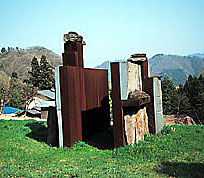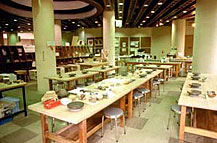 |
 |
 |
| Outdoor sculpture in Fujino |
 |
Take the Chuo Line due west from Tokyo, and only about an hour out, just as you enter the mountains, you will find yourself in Fujino. The tiny train station perched high above the Sagami River gorge gives little hint of the active artists' community tucked away in the hills and valleys of this bucolic corner of Kanagawa Prefecture.
Fujino actually has a proud history as an artists' colony. In the closing days of World War II some sixty of Tokyo's most prominent artists evacuated to this village, not only to avoid the air raids but with the goal of building a "city of artists" here. The first refugees included such luminaries as Leonard (Tsuguharu) Foujita, and they were joined by more in the years after the war. Since the 1970s a number of foreign-born artists -- painters, potters, weavers -- have discovered the solitary (yet not too far from the big city lights) splendors of Fujino as well.
Sadly, the recent fortunes of the town reflect the general economic malaise that followed the bursting of Japan's "bubble economy." In the nineties Fujino tried to capitalize on its legacy and bill itself as an "art resort" in hopes of increasing its artist population and attracting art-minded tourists. For some years there was an annual Fujino International Art Symposium, but that appears to be dormant.
One product of the "art resort" campaign that has managed to keep its doors open, however, is the Fujino Workshop for Art, an exquisitely designed facility that boasts a large crafts workshop, a 300-seat concert hall, rehearsal studios, and overnight lodging. Built in 1995 and operated by Kanagawa Prefecture, the Workshop seems to have weathered the post-bubble recession, yet its facilities are woefully underused. A look at this year's schedule reveals only the occasional concert in that lovely hall, and any art exhibits on the premises appear to be of the rental variety. However, there are workshops in pottery, woodworking, glassblowing and the like on a nearly daily basis, attended by local housewives, schoolkids, and the occasional out-of-town visitor.
Perhaps inevitably, Fujino is taking the same dubious route to economic salvation of many small municipalities in Japan today: on March 11 it will merge with its neighbor, Sagamihara City. Whether this improves the town's finances without comprising its identity as an artistic enclave remains to be seen. But Fujino, whatever its hardships, is well worth a visit. In a day one can take in the Workshop, hike along the nearby hills on the Art Road (Geijutsu no Michi) past numerous outdoor sculptures, and top it all off with a dip in one of the area's many hot springs.
 |
 |
 |
 |
|
|
|
left: View of the Fujino Workshop for Art
right: Crafts workshop, Fujino Workshop for Art
All images courtesy of the Fujino Workshop for Art |
|